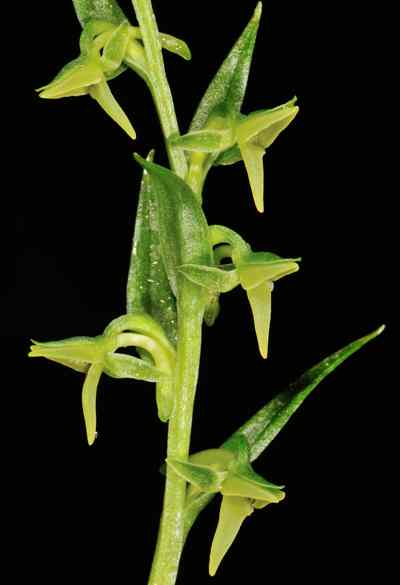The plant
Terrestrial. Whole plant 12 to 30 cm in height. Tubers two, elongate, cylindrical, tapering to both ends, with stout long roots arising from the base of the stem. Base of the stem sheathed. Stem cylindrical, with a solitary, oblong to oblanceolate, acute leaf, tapering to a short-sheathed base, 4 to 7 cm long and 1.5 to 2 cm in width. Above the solitary leaf, another solitary, long, erect, 3 to 5 cm long and less than 1 cm in width lanceolate bract is present. Flower many in a spike longer than the stem, ridged.
The Flower
Flower large, about 1.5 to 2 cm across. Sepals equal, elliptic, dorsal diagonally erect; lateral spreading and curved back. Petals lanceolate, as long as the dorsal sepal and arranged perpendicular to it. Lip lanceolate, fleshy, pointing downwards. Spur curved, longer than the ovary, cylindrical with broadened apex. Floral bract erect, lanceolate, longer than the decurved ovary, diminishing in length to the apex of the spike, arising from the lower portion of the ovary.
Sepals green. Petals and lip yellowish green. Spur pale yellow. Floral bract green.

The Pursuit
This is a very rare species of the region, with its habitats spreading currently across Central and East Himalayas as well as China (Sichuan and Yunnan).
I too was surprised with its features and elusive nature, and made a point to put extra efforts to find it. Along with my alpine work I was concentrating above 10,000 ft in the monsoon months. We were camped in a small hamlet along the roadside. The area was totally cut off from any communication network and even electricity. Those days were the hardest of all days in the alpine region. Every day we trekked many kilometers in very hostile climatic conditions and wildlife activities. But, each day produced some exiting discoveries, which made us really happy at the end of the day. An elderly neighbour told us about two lakes at the top of a flat mountain a few kilometers from there. One day we decided to trek up there. The ascent up the mountain was so tiring. It took more than 4 hours to climb around 1200 m. At the top of the mountain, the entire topography changed to a different world. It was like a plateau with more than 15 km in length and some 8 km wide. The entire plateau was covered with hardly 1 to 1.5 m high Rhododendrons. The forest floor was full of many plants. The two lakes were not so large; they were just 40 to 50 m wide and about the same in length. As a tradition in the Himalayas, we burned some incense and prayed there and trekked ahead. We found many species of flowering plants all over the region. But something special was still missing. All those we came across were the ones I had found earlier from various regions of the Himalayas. After around 3 km of trekking I noticed an area that seemed like a small valley, which was full of Rhododendron trees. The dense growth of the plants made me think that there will be no plants inside those thickets. Hence, we moved ahead along the side of those trees. As we trekked ahead I was glanced my eyes on the forest floor for something unusual. As we were about to the transverse the last part of those thickets I found a robust plant of less than 1 ft in height. The strong features of that small plant attracted my attention and I crawled down under those thickets to it. To my surprise it was this species, just a single specimen with 7 buds of which three were in bloom. It was such a surprise that a plant believed to be very elusive was growing as elusive itself – deep inside a thick thicket of Rhododendrons. As the thickets were dense it was not at all possible to be near to the plant to make sketches or photograph it. We were left with no options other than removing the plant and bringing it out to the open area. Before doing that, we searched the whole area by crawling under those thickets on wet moist moss covered ground for about an hour in search of more plants. My assistant was able to locate 3 more plants from there, but with withered flowers. Then we decided to gently remove the plant we spotted first and made sketches and photographs from it and replanted it back at its original position. Even though I had removed a plant from its habitats on a few occasions only, each time I pay much attention not to damage it in any way. Every time, I made it a point to replanted it on the same location.
Later on, in the last year of my alpine work I found 2 more plants of this species but was not able to visit them while it was in flower.
Reference:
King, G. & Pantling, R. (1898). The Orchids of the Sikkim-Himalayas. Ann. Roy. Bot. Garden. (Calcutta).Habenaria oligantha Hook., Page no 325.